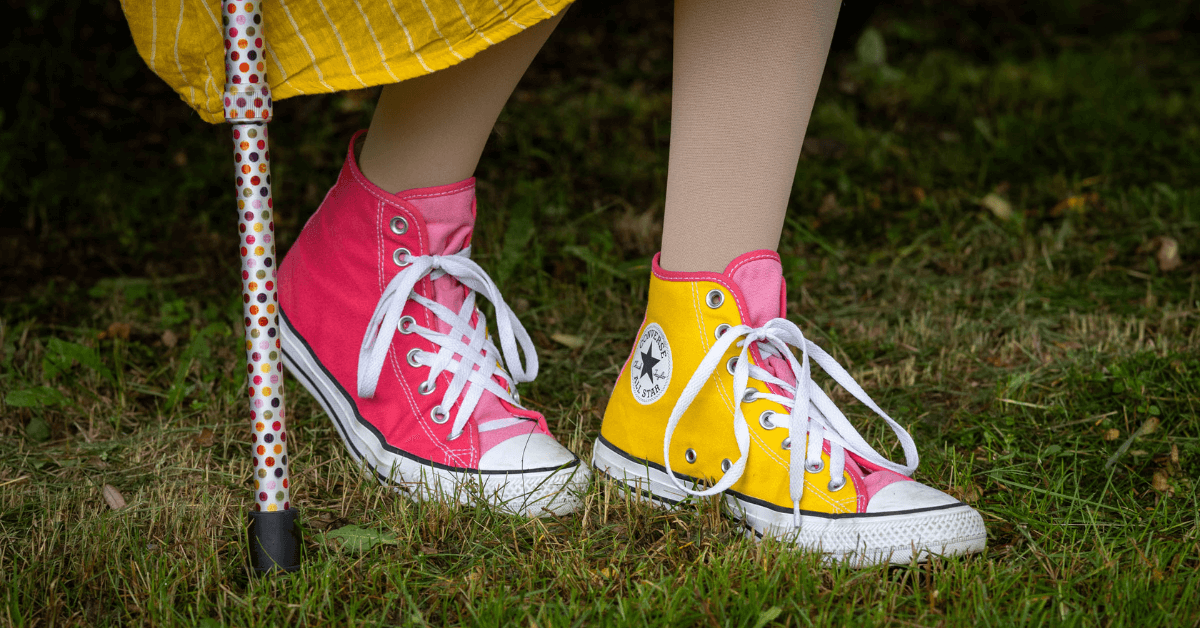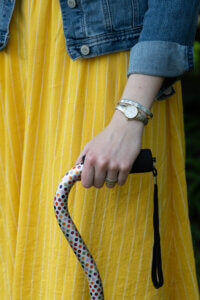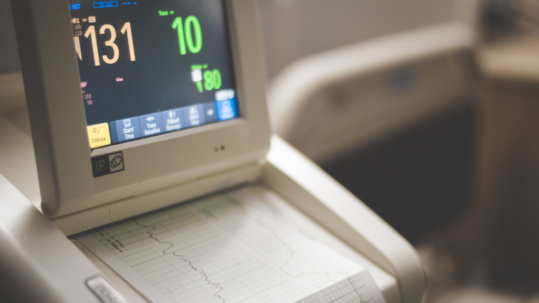
31 Jul Why I Use a Cane With POTS
The first time I used a cane, I brought it to a giant craft store to “test it out” and meandered the aisles getting used to the feel – both practically (how it helped my condition), but also personally (how it changed the way I felt about myself). I got back in the car, CERTAIN I would never use one again, and wishing I had left the tag on. It was awkward to use, noisy (more on that later), and honestly, humiliating. I was all of 20, and had not enjoyed the seemingly “neon” indicator of my issues. But 6 months later, I have 100% changed my mind, and that’s what I’m here to discuss.
There are many ways to navigate the symptoms of postural orthostatic tachycardia syndrome (POTS), specifically, those of feeling lightheaded, dizzy, or off-balance. Mobility aids range from wheelchairs, to canes, to service dogs, and even the generous arm of friends and family. Certainly, they each have their place depending on the person, their preference, and the season they find themselves in. But whether you’re a new potsy looking at your options, or a seasoned spoonie tired of feeling anxious or unsteady while in public, this article is for you.
When I Began Using a Cane
I started researching canes when my orthostatic symptoms (or, symptoms while standing) were noticeably impacting my feeling of medical safety/security while in public. Typically, my Dad would loop his arm around mine, my sister would push me in a cart, or my friends would make a Kaley-sandwich to keep me on track. But more than once, I collapsed to the ground after standing up from crouching to look at a product, and there were several instances when my sister would give me a forceful hug to keep me steady when I would sway with dizziness (“I can feel your heart racing” she would whisper). It was these situations that helped me realize that a mobility aid of some kind might be helpful and contribute to safety, especially when I ventured into my own aisle or navigated appointments on my own.
Learning to Use a Cane
I acquired my cane from Walmart and got the $8 polka dot, lightweight and adjustable cane in the pharmacy section. As I mentioned before, my first few experiences were not overly positive, but once I started going to physical therapy I pulled it out again. I figured if there was anyone who could help me decide on its helpfulness once and for all, it would be my new physical therapist (read more about my experience with physical therapy here).
 I think my favorite moment was looking over at her as she was fitting it to me, realizing that after she adjusted the height, she tightened the little ring that was halfway down the cane. I laughed quite hard, realizing the jiggly “clank” sound that followed me everywhere was actually just the loose adjustment ring. Once she got the right size, tightened the ring, and showed me how to use it, it was a completely different experience than I’d had before. Instead of feeling like I was “awkwardly carrying around a noisy random stick”, it felt like a natural extension of my body. Over the next few outings, I was completely convinced that a cane was beneficial for my safety, confidence, and independence.
I think my favorite moment was looking over at her as she was fitting it to me, realizing that after she adjusted the height, she tightened the little ring that was halfway down the cane. I laughed quite hard, realizing the jiggly “clank” sound that followed me everywhere was actually just the loose adjustment ring. Once she got the right size, tightened the ring, and showed me how to use it, it was a completely different experience than I’d had before. Instead of feeling like I was “awkwardly carrying around a noisy random stick”, it felt like a natural extension of my body. Over the next few outings, I was completely convinced that a cane was beneficial for my safety, confidence, and independence.
I love using a cane for mobility. Here’s why:
When I stand up from sitting, I use my cane to help stabilize me.
When standing up from crouching, I can use the cane to help pull me up.
When experiencing presyncope, I lean on the cane with downward pressure to help keep me from falling.
When feeling disoriented, I have a firm third point on the ground that helps keep me steady.
When I walk down a hallway, the cane helps me walk in a steady line without feeling like I have to trail my hand against the wall.
With a cane, I am more likely to say “yes” to errands, events, or outings. I am more likely to enjoy myself, and less likely to fall. It’s completely worth it.
Yes, It’s a Cane
I realize that using a cane can be hard for a lot of reasons. When using it, there is no denying that you are visibly managing an illness or injury, and it is certainly a conversation piece, for good or for bad. In the beginning, I went to plenty of public places so I could anonymously try it out, and eventually I decided I wanted to make it a regular part of my leaving-the-house wardrobe. Just like a drastic new haircut, the people who know you at school, church, or the coffee shop are going to notice, and that’s ok. Personally, once I navigated the initial reactions of the people around me, I quickly began embracing the external indicator of the inward struggle. It helps remind myself, and others, that I’m not quite as able-bodied as most people, and that’s ok. It helps me accept help, and gives me rest from the constant “I know I don’t look sick, but…” dialogue, because the fact of the matter is, a cane *does* make it clearly known that you are not completely healthy. Even things as simple as *actually* utilizing my disability parking tag on a bad day has become much more doable, with the cane reassuring myself (and others) that my illness is real, that it has an impact on my daily functionality, and that it is ok to utilize the resources available to make living life easier.
The other great thing is that using a cane doesn’t lock you in for a lifetime – it can certainly be used long-term, but it can also just be a temporary tool in a rough season. It’s ok to leave it in the car on a good day, and it’s ok to use it in your home on a bad day. It’s also just fine to use it at specific places, like church and while grocery shopping, while leaving it at home when going out with friends or when you have the physical support of a spouse or sibling.
My Big Tip
If you are reading this, and thinking, “Hmm. I kinda want to try this,” my BIGGEST tip is to pick a cane that is fun. Years ago, it was seeing another young adult use a cane that bolstered my confidence to try it myself. He had a thin black cane with a gold handle, and the way he merged it with his style (and sass) was inspiring. Whether your style is vintage floral, real wood, or pink and yellow polka dots, let your cane be an accessory that you enjoy incorporating into your life. It will make it more fun, and it will make you more likely to pick it up and bring it with you next time you have an errand to run.
Conclusion
My cane is one of my favorite tools in my POTS toolbelt, because of the tangible sense of security it brings me. If you are struggling with dizziness or balance, I would wholeheartedly recommend looking into (or asking your doctor/physical therapist) if a cane would benefit you. It might take some time to get used to, but in my experience, it’s been worth it.
-
Making a Full Physical Recovery – A Day-by-Day Miracle
“You should exercise more.” A brutal statement. One I had tried to fulfill on my own, and time and time again, had failed. It was a frustrating piece of advice from my doctor, and felt so out of reach as I navigated my bouquet of chronic illnesses....
27 June, 2024 No comment -
Awesome Recovery News!! And Why I No Longer Plan To Write About My Symptoms
I am so excited to report that after graduating from the 3-week Pain/Symptom Rehabilitation Center at Mayo Clinic in Rochester and continuing the program at home, I am nearly 100% recovered!...
05 March, 2024 3 Comments -
What is the Valsalva Maneuver like?
The Valsalva maneuver is EASILY the most fascinating thing I’ve gotten to do in this entire medical adventure. On the surface, it’s a fairly quick and easy part of autonomic testing, but underneath, it’s one of the coolest and most complicated mechanisms of the human body that I’ve encountered. ...
17 January, 2024 3 Comments






Pingback:5 Practical Tips for Physical Therapy with POTS - Kaley Faith
Posted at 19:23h, 13 October[…] with practical things like fitting me to my cane (check out my article discussing why I use a cane here). My body is slowly rising up to meet the demands of living a healthy life (like keeping up with my […]
Pingback:Mayo Clinic for POTS - A Quick Overview of My Experience - Kaley Faith
Posted at 16:45h, 02 November[…] life I use a cane to help stabilize and support me while standing and walking (read more about that here), but at Mayo Clinic we quickly realized that I needed to be pushed in a wheelchair. The buildings […]
Cassidy Moore
Posted at 14:29h, 09 Novemberjust got diagnosed with POTS at 22 as an active young person. It’s been so scary and my entire life has turned upside down. Your blog has helped so much and made me feel less alone. Thank you so much!!
Kaley
Posted at 14:45h, 09 NovemberI am so sorry you are navigating a new POTS diagnosis – I understand how jarring and foreign it can feel. Kudos to you for learning, researching, and seeking others with POTS who can encourage you on your journey and help you feel less alone. It goes both ways! I am SO glad you are encouraged by my blog, But I TOO, am encouraged to hear from you, and to know that there are others just like me on this long journey towards recovery.
I wish you all the best Cassidy!
Kaley
Pingback:My 8 POTS Essentials - Kaley Faith
Posted at 08:28h, 06 December[…] Using a cane was a big step for me, and one that took time. As my POTS symptoms worsened over the last year, I found myself having more issues with balance and often felt afraid that I was going to collapse at any moment. I was trailing my hand along walls, using counters or nearby chairs to stabilize myself, and had fallen to the ground after getting up too quickly on more than one occasion. Using a cane makes me feel safe, stable, and more confident. I have a whole article discussing using a cane for POTS, and you can check it out here. […]